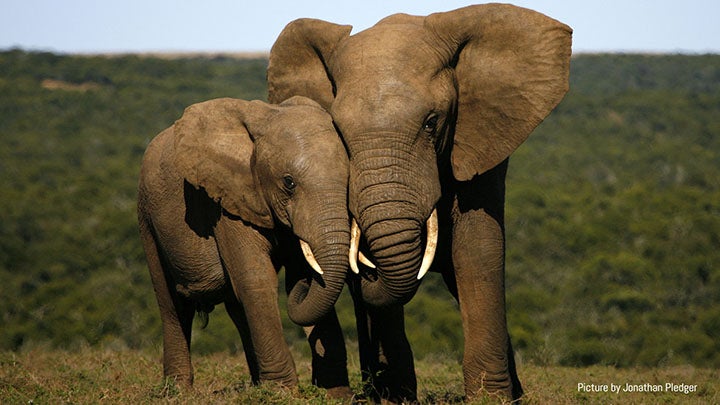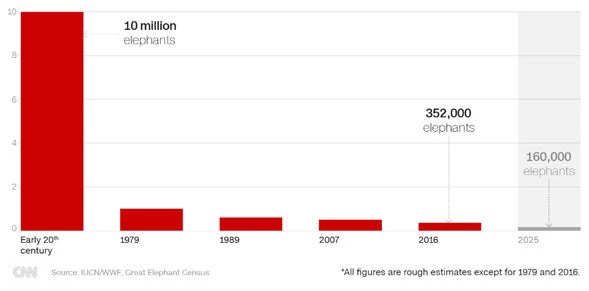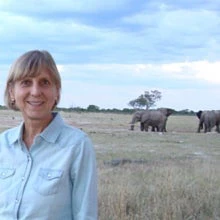
By the end of today, 96 African elephants will have been killed. Due to this rate of poaching, the current African elephant population is estimated to have fallen to just 415,000 (IUCN 2016) and the situation is even worse for Asian elephants with an estimated population of about 50,000 (IUCN Red List). This is extremely heartbreaking because not only do elephants have intrinsic value but they are also one of the few flagship and keystone species. If they disappear, the entire ecosystem will collapse.
As we celebrate World Elephant Day on August 12th, I reflect upon what I have learned and realize that to be able to save the largest terrestrial mammal on Earth, we need to protect their habitats, stop the violent poaching and trafficking, support communities that are affected by human-elephant conflicts, and stop the demand for ivory.

decline of elephant populations in Africa over the past 100 years.
Protecting elephants across Africa
In 2010, I started working in the World Bank’s Africa region to manage Global Environment Facility (GEF)-funded biodiversity and development projects. The first project I worked on was in the Greater Addo Elephant Project in the Eastern Cape region of South Africa. The project supported the expansion of the Addo Elephant National Park, increasing the habitat range for 550 savannah elephants and also generating significant tourism income totaling $16 million.
As my work in Africa expanded, I started to support projects in Botswana, Namibia and Zimbabwe. The project in Zimbabwe focused on managing the increasing elephant population of Hwange National Park, which was approximately 44,000 and the park was reaching its carrying capacity. The project was built to address inadequate water supply for wildlife and humans, destructive wild fires, poaching of wildlife, human-wildlife conflicts, and also to expand livelihood options in order to create economic incentives for communities to protect wildlife.
The project in Botswana focused on human-wildlife conflicts. Botswana has a population of about 2.2 million people and an estimated 130,000 elephants (the largest in Africa), however, less than 30% of the elephants stay within protected areas. As agricultural land increased, the areas for elephants to roam outside protected areas were diminishing, resulting in crop loss for communities. The project piloted different prevention techniques such as chili pepper fences, but the most successful approach was to provide skills and training for youth in nature-based tourism.

Increasing scale of threats to elephants
Until five years ago, I had not worked on projects that were facing the massive wildlife-poaching crisis. It is when I started working in Mozambique, Zambia and Tanzania that I realized we were losing the battle. Armed militia, rebel groups, networks of traffickers, wholesalers and a burgeoning demand for ivory was fueling the ivory supply chain and escalating elephant deaths at an alarming rate. Many countries in East, West and Central Africa were seeing elephant populations plummet—Tanzania saw a decline of 60% in the last five years.
I started seeing dead carcasses of elephants, talking to park rangers about their experiences with these creatures, seeing their matriarchal society, watching them protect their babies, and also destroying a crop field, or charging at us while taking a game ride. I can recount many such incidents of the human-like behavior of elephants that make them such an emotional and vulnerable species.
Elephants are one of the most intelligent mammals on Earth
Science has proved that elephants are highly social and intelligent animals. In this TED Talk, you can learn about their wide variety of behaviors including empathy, grief, ability to use of tools, self-awareness and coordination.
On a recent mission to La Lope National Park in Gabon, I had an insightful conversation with a park ranger who mentioned the Parks Agency had recruited a former elephant poacher. Every time the former poacher accompanied them on patrol to monitor the forest elephants the elephants must have sensed danger and charged them. When the park rangers patrolled the same area without the former poacher, they had no terrifying elephant encounters. Eventually, the former poacher resigned because he did not want to endanger the lives of the other park rangers.
During the same visit, in an interview with Prof. Lee White, Executive Secretary of Gabon’s National Parks Agency, he described a time where he saw an elephant herd deeply mourn the loss of a family member by burying the body under leaves and branches. In one of my favorite books, The Elephant Whisperer: My Life with the Herd in the African Wild, the author Lawrence Anthony describes how he was able to help a wild elephant herd and in so doing created a deep bond with them.
International action and commitment is the way forward to save the elephants
In response to the international call to action, 19 countries from Asia and Africa have agreed to form a partnership called the Global Wildlife Program (GWP) to combat illegal wildlife trade, which is funded by the GEF and that I am leading at the World Bank. Fourteen of these countries are investing in solutions to save elephants by strengthening anti-poaching efforts, improving community wildlife management, reducing ivory trafficking and raising awareness to reduce demand for ivory. My team and I have organized several conferences where our stakeholders learn from one another and take collaborative action to tackle wildlife trade.
In October, in collaboration with the Government of India, we will organize the annual GWP conference and do a study tour for various GWP members to visit a World Bank-led project in Sri Lanka on wildlife corridor management. Sri Lanka is a country with high human population densities and a very significant elephant population (estimated at around 4,000 or more). If the solutions work there, they can be replicated anywhere. I am excited that my work will lead me to learn more about the Asian elephants.
I am hopeful that through the GWP partnership and with the help of the international community, we can prevent the elephant extinction crisis. Please play an active role by raising awareness on this issue and support local conservation organizations.
I want to take this opportunity to thank all those people I have encountered that are working tirelessly to save the elephants.
Related blogs:
Why law enforcement is essential to stopping illegal wildlife trade
Corridors to coexistence: reducing human-wildlife conflict
Reducing demand must be a core component of combatting wildlife crime


Join the Conversation